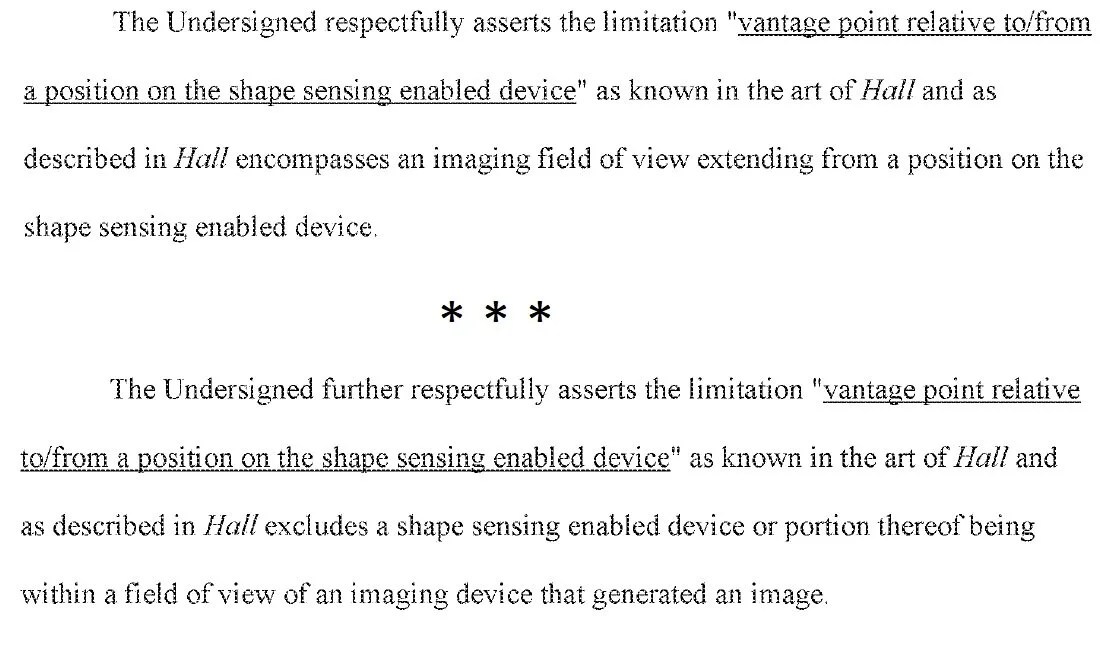There is no one way to argue against a prior art rejection, even when the rejection is under Section 102. At a basic level, most arguments against the substance of a 102 rejection revolve around the cited reference lacking disclosure of a claim element. And one scenario where that is very clear is where the applicant can establish that, beyond the claim language requiring a feature missing from the prior art, the claim language actually excludes what is shown in the prior art. While this scenario occurs relatively rarely in practice, some applicants can over play their hand by making such an argument when it does not actually apply or is not supported by evidence.
Phillips recently found itself in such a situation when appealing the rejection of their application 15/572,352.
Claim 1 on appeal (emphasis added):
A system for providing a perspective for a virtual image, comprising:
an intraoperative imaging system having a transducer configured to generate an image data set for a region; a shape sensing enabled device which includes at least one optical shape sensing fiber and is configured to have at least a portion of the shape sensing enabled device positioned relative to the region, the shape sensing enabled device having a coordinate system registered with a coordinate system of the intraoperative imaging system; and an image generation module configured to render a virtual image of the intraoperative imaging system for at least a portion of the region using the image data set wherein the virtual image includes a vantage point relative to a position on the shape sensing enabled device, said vantage point being determined by shape sensing information obtained from the at least one optical fiber.
Phillips relatively short (in substance) appeal brief presents a singular argument against the rejection that appears to expressly rely on the assertion that the claim scope is focused on the example embodiments in the Applicant’s specification (where the Applicant’s specification is referred to as Hall), and excludes the disclosure of the prior art:

As could be expected, this argument fell flat at the PTAB, which dismissed it with a paragraph:
… the argued claim limitation in its full context requires “using the image data set wherein the virtual image includes a vantage point relative to a position on the shape sensing enabled device.” Here, the argued claim limitation only requires that the image data set “includes” the “vantage point relative to a position on the shape sensing enabled device,” and does not require excluding other data. In Figure 2 of Zhao the catheter system (202) has one or more camera probes (226) at the distal end (218). Thus, a camera probe (226) provides “a vantage point relative to a position on the shape sensing enabled device” which is that from the catheter’s (202) distal end. In Zhao the data from the camera probe (226) at this distal end would be used by the imaging system (212) in the virtual visualization system (208). … Further, at paragraph 31 of Zhao it is disclosed that in some embodiments a virtual image “present[s] the surgeon S with a virtual image of the internal interventional site at the location of the tip of the interventional instrument” which additionally discloses the argued claim limitation. For these above reasons, the rejection of claim 1 is sustained.
While there may have been strong arguments that the references lacked a claimed feature, because the argument was couched as the claims excluding what was disclosed by the cited art, it was relatively easy for the board to dismiss the argument and as a default affirm the rejection. So, be careful to keep the scope of your arguments in line with the claims and evidence.

Leave a comment